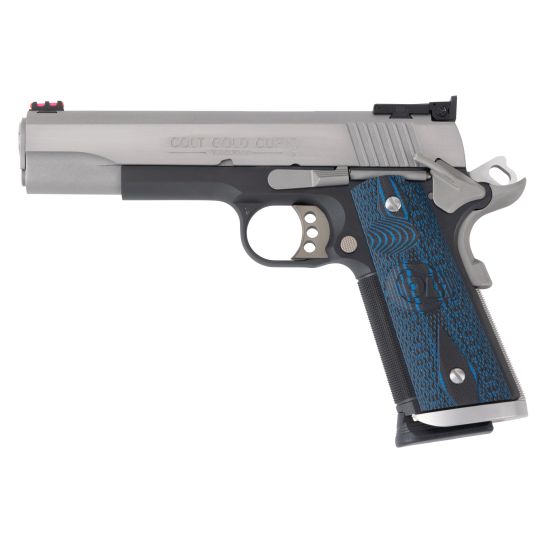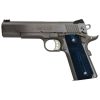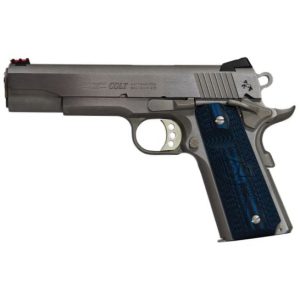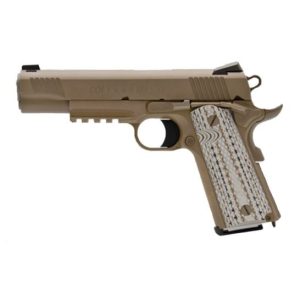Colt .45 ACP 1911 Pistol, 5" Barrel, Fiber Optic Sights, Silver, Black – O5970XETT For Sale
$1,654.99
The Colt .45 ACP 1911 Pistol, model O5970XETT, seamlessly merges classic design with contemporary functionality, making it an excellent choice for both firearm enthusiasts and professionals. Characterized by a 5″ barrel and a stylish silver and black finish, this model emphasizes reliability and aesthetic appeal. Building on the esteemed Colt M1911 platform, which has been favored for over a century, it excels in roles ranging from a service pistol to a personal defense weapon. Key features include rugged G10 grips for a comfortable hold and an upswept beavertail grip safety to enhance shooting control while reducing accidental discharge risk. The pistol is fitted with adjustable sights and a fiber optic front for quick target acquisition and improved accuracy across various lighting conditions. Combining traditional craftsmanship with innovative elements, this Colt model honors the M1911 series’ legacy while meeting modern shooting needs.
Is .45 colt and .45 ACP the same?
No, .45 Colt and .45 ACP are not the same. They are two distinct types of ammunition. The .45 Colt, also known as .45 Long Colt, is a longer, rimmed cartridge primarily used in revolvers. The .45 ACP (Automatic Colt Pistol), on the other hand, is a shorter, rimless cartridge designed for use in semi-automatic pistols. Each type of ammunition is suited to different firearm designs and cannot be used interchangeably.
How much is a classic 1911 Colt?
The price of a classic 1911 Colt can vary significantly based on factors like its condition, historical significance, rarity, and any unique features or provenance. Generally, prices can range from a few hundred dollars for a well-used model to several thousand dollars for a rare or collector’s piece. For a more accurate estimate, it’s best to consult recent sales data from auctions or firearms dealers.
Why do 1911s jam so much?
The jamming issues in 1911 pistols can typically be attributed to several factors, though it’s important to note that modern 1911s from reputable manufacturers are generally reliable. Here are some common reasons for jamming:
1. **Ammunition Issues**: Using low-quality or improperly sized ammunition can lead to feeding problems and jams. 1911s can be particularly sensitive to bullet shape and overall cartridge dimensions.
2. **Magazine Problems**: Worn or poorly designed magazines can cause feeding issues. The magazine’s follower and spring play critical roles in ensuring smooth cartridge feeding.
3. **Poor Maintenance**: Like all firearms, 1911s require regular cleaning and lubrication. Accumulated dirt, carbon, and fouling can impede the action.
4. **Extractor Issues**: The extractor must be properly tensioned and shaped to ensure reliable extraction of spent cartridges. An improperly tuned extractor can lead to jams.
5. **Recoil Spring**: An ill-fitting or worn recoil spring can cause cycling problems, affecting the gun’s ability to return to battery properly.
6. **Tight Tolerances**: Some custom or competition 1911s have very tight tolerances to enhance accuracy, which can make them more prone to jamming if not properly maintained.
7. **User Error**: “Limp-wristing,” or not maintaining a firm grip and wrist lock, can result in insufficient resistance to the recoil, causing feeding problems.
8. **Aftermarket Parts**: Using non-standard or improperly fitted aftermarket parts can lead to reliability issues.
Addressing these factors with proper maintenance, quality components, and suitable ammunition can greatly enhance the reliability of a 1911 pistol.
How much did a 1911 cost in 1911?
A Colt M1911 pistol in 1911 typically cost around $15 to $20 when it was initially adopted by the U.S. military.
Can a 45 ACP be shot in a 45 long colt?
No, a .45 ACP (Automatic Colt Pistol) cannot be safely shot in a .45 Long Colt chamber. The two cartridges are different in terms of their dimensions and design. The .45 ACP is a rimless cartridge designed for semi-automatic pistols, while the .45 Long Colt is a rimmed cartridge intended for revolvers. Attempting to fire a .45 ACP cartridge in a .45 Long Colt chamber can result in dangerous malfunctions or damage to the firearm. Always ensure that the ammunition matches the specifications of the firearm you are using.
Is 45 Colt stronger than 9mm?
Yes, the .45 Colt generally has more stopping power and delivers more energy on impact than a 9mm round, due to its larger bullet size and heavier weight. However, modern advances in 9mm ammunition design have made it very effective for self-defense, with higher capacity and lower recoil, making it a popular choice for many. Overall, while the .45 Colt is traditionally stronger, the effectiveness of these calibers can depend on specific ammunition types and intended use.
Do Colt 1911 hold their value?
Yes, Colt 1911 pistols tend to hold their value well. The Colt 1911 is a classic firearm with a long history and is highly regarded for its craftsmanship, reliability, and historical significance. These factors contribute to its enduring popularity and strong resale value. Collectors and firearm enthusiasts often seek out Colt 1911 models, particularly those that are in good condition or have unique features, further helping them retain their value over time.
Why is the Colt 1911 so famous?
The Colt 1911 is famous for several reasons:
1. **Historical Significance**: Designed by John Browning and adopted by the U.S. military in 1911, it served as the standard-issue sidearm for the U.S. armed forces for more than 70 years. Its use in World Wars I and II, the Korean War, and the Vietnam War highlights its historical importance.
2. **Innovative Design**: At the time of its introduction, the 1911 featured innovative design elements, such as a short recoil operation and a single-action, semi-automatic mechanism. These features contributed to its reliability and performance.
3. **Durability and Reliability**: The Colt 1911 is renowned for its durability and reliability in various conditions. It functioned well in adverse environments, adding to its reputation as a dependable firearm.
4. **Cultural Impact**: The 1911 has become a cultural icon, appearing in numerous movies, TV shows, and video games. Its distinctive design and historical usage have cemented its status in popular culture.
5. **Customization and Versatility**: The design of the 1911 allows for significant customization, making it popular among gun enthusiasts for personal modifications and competition shooting.
6. **Legacy and Influence**: The 1911’s design has influenced many other semi-automatic pistols, and its continued popularity is evident in the numerous variations and modern reproductions available today.
These factors combined have contributed to the Colt 1911’s enduring fame and iconic status in the world of firearms.
Is a 38 super stronger than a 9mm?
The .38 Super is generally considered to be a more powerful cartridge than the 9mm. The .38 Super typically has a higher velocity and energy compared to standard 9mm rounds. This results in a flatter trajectory and more stopping power, which can be advantageous in certain shooting scenarios. However, the 9mm is more widely used, has less recoil, and is generally more affordable and available. The choice between the two often depends on personal preference and the specific use case.
What is the weakness of the 1911?
The main weaknesses of the 1911 handgun include its relatively low ammunition capacity, compared to modern handguns, typically holding 7 to 8 rounds in a standard magazine. Additionally, it can be prone to reliability issues if not properly maintained or if using non-standard ammunition. The design is also seen as more complex and heavier compared to more contemporary firearms, which might affect ease of use, particularly for those unfamiliar with its operation and maintenance.
Which gun is known for jamming?
The M16 rifle, particularly the early models used during the Vietnam War, is often noted for its jamming issues. These problems were primarily attributed to the use of improper gunpowder and a lack of cleaning and maintenance instructions provided to soldiers.
Do 1911s jam with hollow points?
1911 pistols can experience jamming issues with hollow point ammunition, although this depends on several factors, including the specific firearm, the type of hollow point ammo, and how well the gun has been maintained or modified. Traditional 1911 pistols were designed for round-nosed, full metal jacket (FMJ) cartridges, so they might not always feed modern hollow points as reliably without some modification or tuning.
However, many manufacturers now produce 1911 models that are designed to handle hollow point ammunition more reliably. Additionally, polishing the feed ramp, using quality magazines, and ensuring the gun is clean and properly lubricated can help reduce the chances of jamming when using hollow points. Testing your specific 1911 with your chosen hollow point ammo is the best way to ensure reliability.
What is the difference between the 1911 and the 1911a1?
The primary differences between the original M1911 and the M1911A1, which was an updated version introduced in the 1920s, are as follows:
1. **Trigger**: The M1911A1 features a shorter trigger compared to the original M1911.
2. **Mainspring Housing**: The M1911A1 has an arched mainspring housing, whereas the M1911 had a flat mainspring housing.
3. **Grip Safety**: The beavertail on the M1911A1 was extended slightly to avoid “hammer bite,” which was more common on the original M1911.
4. **Sight**: The sights on the M1911A1 were enlarged to improve accuracy and target acquisition.
5. **Fingergrooves**: The M1911A1 includes cuts around the trigger area (fingergrooves) to make it easier for the shooter to access the trigger.
6. **Hammer Spur**: The hammer spur on the M1911A1 was shortened.
7. **Frame**: Minor modifications were made to the frame to improve ergonomics and ease of use.
Overall, the changes were implemented mainly to enhance the ergonomics of the weapon and to improve shootability. Both models are functionally very similar and share the same basic design principles.
How much was $100 worth in 1911?
In 1911, $100 would have had the purchasing power of approximately $3,000 to $3,500 in today’s terms, based on average inflation rates. This is a rough estimate and the actual value could vary depending on the specific goods or services considered.
What are the three sizes of 1911?
The three main sizes of the 1911 pistol are:
1. **Full Size (Government Model)**: Typically features a 5-inch barrel and is the standard size for the original 1911 design.
2. **Commander**: Usually has a 4.25-inch barrel, offering a slightly shorter length while maintaining a full-size grip.
3. **Officer**: Has a more compact design with a 3 to 3.5-inch barrel and a shorter grip, designed for easier concealment.
Be the first to review “Colt .45 ACP 1911 Pistol, 5" Barrel, Fiber Optic Sights, Silver, Black – O5970XETT” Cancel reply
Related products
Colt .45 ACP 1911
Colt .45 ACP 1911
Colt 1911 .45acp Rail Gun M45A1 Pistol , Decobond Brown – O1070M45




Reviews
There are no reviews yet.